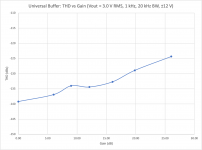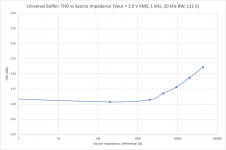One of these days I would like to measure transient THD. So for example the change in THD when an amp goes from producing 10 mW to 10 W. It would be interesting if that could tease out some of this stuff. There could be other aspects of transient response at play too.
Tom
Probably need to approach this like one would do, to measure settling time to a very fine accuracy. Local thermal heating in the semiconductors can affect the result, as well as the stiffness of the power supply.
Same for a common emitter stage. And even if there is no discrete degeneration resistor, the internal re of the transistor will provide local feedback. You just won't have much control over the feedback factor (unlike with external degeneration).There is always at least local feedback through regeneration. So for example a differential pair has emitter resistors to control the gain through regeneration.
Tom
TIM was somewhat of a red herring -- what was going on was real but mis-attributed. The proposed solutions were also a bit over-done as simpler 'cures' exist. Walt Jung showed that it was really slew limiting in the power amp, especially its input stage. Bob Cordell also wrote a couple illuminating articles, for the old Audio mag, I believe.
This is the earliest reference to TIM/SID that I'm aware of:
Jung, W.G., Stevens, M.L., & Todd, C.C. (1977). Slewing induced distortion and it's (sic) effect on audio amplifier performance – with correlated measurements/listening results. AES.
There's a pre-print of the article, which was presented at the AES convention in May of 1977. You may be able to dust that up if you search hard enough. Otherwise, renew your AES membership and jump the paywall... 🙂
The three had a 3-part series in Audio Magazine (1979) titled "An Overview of SID and TIM" and Walt Jung had a similar 3-part series in Audio Amateur (1977), "Slewing Induced Distortion in Audio Amplifiers". They're worthwhile reading.
Tom
Last edited:
Matti Otala's original articales on 'TIM' preceded Jung by several years and became all the rage. I believe most were AES convention preprints/presentations or JAES papers (or both). Jung's SID articles were in response, showing that there was a much simpler mechanism at work and much easier 'fix' to the problem.
Ah! You're right.
Otala, M. (1970). Transient distortion in transistorized audio power amplifiers. IEEE Transactions on Audio and Electroacoustics. AU-18(3).
Tom
Otala, M. (1970). Transient distortion in transistorized audio power amplifiers. IEEE Transactions on Audio and Electroacoustics. AU-18(3).
Tom
I finally found time (and developed the tools) to allow me to measure the THD vs gain. See attached.
The UB behaves about as I would have expected. Basically, as you increase the gain, you increase the THD as the increase in gain results in a reduction in loop gain. It's not quite a 1:1 relationship (it's actually a little better), but it's pretty close.
The blip at 9 dB gain is due to a range change on the APx525 source.
I used a 5th order elliptical filter to clean up the source. The filter notches out the 2nd and 3rd harmonic and attenuates everything from H4 and up by 50+ dB. The cleaned up source goes to the DUT.
The output of the DUT then goes through a balanced receiver and a notch filter, which allows me to extend the measurement capability of the APx525.
I measured at 3 V output voltage as that's the sweet spot on the AP for THD. Even with my fancy tricks, I'm still pushing the limits of the instrumentation.
The UB was powered by a Preamp Power Supply providing ±12 V.
Tom
The UB behaves about as I would have expected. Basically, as you increase the gain, you increase the THD as the increase in gain results in a reduction in loop gain. It's not quite a 1:1 relationship (it's actually a little better), but it's pretty close.
The blip at 9 dB gain is due to a range change on the APx525 source.
I used a 5th order elliptical filter to clean up the source. The filter notches out the 2nd and 3rd harmonic and attenuates everything from H4 and up by 50+ dB. The cleaned up source goes to the DUT.
The output of the DUT then goes through a balanced receiver and a notch filter, which allows me to extend the measurement capability of the APx525.
I measured at 3 V output voltage as that's the sweet spot on the AP for THD. Even with my fancy tricks, I'm still pushing the limits of the instrumentation.
The UB was powered by a Preamp Power Supply providing ±12 V.
Tom
Attachments
And now THD vs source impedance. This could be relevant if you plan to use the Universal Buffer as a preamp where it is preceded by a volume control.
This measurement shows that the THD of the Universal Buffer is not impacted by the volume pot as long as the resistance of the pot is 10 kΩ or below.
Recall that the worst case output impedance of a volume pot (or "passive preamp" if you prefer) is Rpot/4. So with a 10 kΩ pot you'd be sitting at the last data point just before the THD starts to rise.
It should be noted that the rise in THD could very well be due to the signal source. With the higher source impedances I had to crank the amplitude up quite a bit due to the voltage division between the source impedance and the 48 kΩ input impedance of the Universal Buffer.
Tom
This measurement shows that the THD of the Universal Buffer is not impacted by the volume pot as long as the resistance of the pot is 10 kΩ or below.
Recall that the worst case output impedance of a volume pot (or "passive preamp" if you prefer) is Rpot/4. So with a 10 kΩ pot you'd be sitting at the last data point just before the THD starts to rise.
It should be noted that the rise in THD could very well be due to the signal source. With the higher source impedances I had to crank the amplitude up quite a bit due to the voltage division between the source impedance and the 48 kΩ input impedance of the Universal Buffer.
Tom
Attachments
Here's my take on the Neurochrome preamplifier using the Universal Buffer, preamp PSU and source selector.
The project is work in progress and should be completed in the coming week or so. Currently awaiting two sets of RCA connectors and one set of XLR for the second Universal buffer that will be used to convert balanced to unbalanced.
Front panel was done by myself using a router. It not perfect but the buttons will fit nicely in the holes and hide the little defects on the source selector hole. Also made 6 tiny holes for displaying the source. Red LED are used for unbalanced and blue LED for balanced source. Power switch is Bulgin bi-color LED.
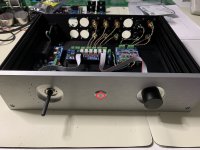
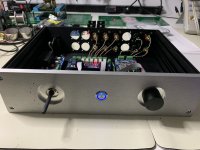
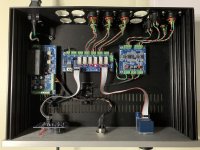
Thanks Tom for such great products, detailed manuals and top notch support!
Do
The project is work in progress and should be completed in the coming week or so. Currently awaiting two sets of RCA connectors and one set of XLR for the second Universal buffer that will be used to convert balanced to unbalanced.
Front panel was done by myself using a router. It not perfect but the buttons will fit nicely in the holes and hide the little defects on the source selector hole. Also made 6 tiny holes for displaying the source. Red LED are used for unbalanced and blue LED for balanced source. Power switch is Bulgin bi-color LED.



Thanks Tom for such great products, detailed manuals and top notch support!
Do
Do,
State of the art dude! Always such a pleasure looking at your projects. I have listened to the Universal Buffer and I'll tell you...it's just not there. And this is from a guy who was used to listening to a Bent Audio TAPX with 4 Silver Autoformers ($$$).
Best,
Anand.
State of the art dude! Always such a pleasure looking at your projects. I have listened to the Universal Buffer and I'll tell you...it's just not there. And this is from a guy who was used to listening to a Bent Audio TAPX with 4 Silver Autoformers ($$$).
Best,
Anand.
Last edited:
All,
I wanted to clarify what I meant by "It's just not there..."
"It's just not there" = straight wire with gain = transparency = a very, very, very good thing!
Best,
Anand.
I wanted to clarify what I meant by "It's just not there..."
"It's just not there" = straight wire with gain = transparency = a very, very, very good thing!
Best,
Anand.
All,
I wanted to clarify what I meant by "It's just not there..."
"It's just not there" = straight wire with gain = transparency = a very, very, very good thing!
Best,
Anand.
LOL, I first read it as the development not being there i.e. the UB wasn’t very good. And then I quickly realised what you actually meant!
Hi Anand,
I always look at your projects with great admiration, so thanks for the compliment!
Do
I always look at your projects with great admiration, so thanks for the compliment!
Do
That's a very nice build there, Do.
I'm impressed that you managed to make the counterbores with a router. You still have all your fingers? 🙂 What kind and size bit did you use?
Tom
I'm impressed that you managed to make the counterbores with a router. You still have all your fingers? 🙂 What kind and size bit did you use?
Tom
Hi Tom,
Yep, still got all my fingers! LOL
I used the router to first cut a hole of the proper size inside a piece of hardwood, then used this wooden guide on top of the faceplate (tightly fastened). Used a 1/2" diameter carbide bit (just use good quality router bit) with bearing to follow the wooden shape, 1-2mm depth at a time. I've used a router many times with aluminium and now I'm used to how it reacts, but at the beginning (several years ago), I almost lost fingers and not counting broken bits the flew dangerously fast... I don't recommend unexperienced people to do this, but I've learned to master the art of aluminium cutting with a wood router and now I can do it very safely.
I finished the filling the back panel with just the extra universal buffer as input still MIA.
All the best!
Do
Yep, still got all my fingers! LOL
I used the router to first cut a hole of the proper size inside a piece of hardwood, then used this wooden guide on top of the faceplate (tightly fastened). Used a 1/2" diameter carbide bit (just use good quality router bit) with bearing to follow the wooden shape, 1-2mm depth at a time. I've used a router many times with aluminium and now I'm used to how it reacts, but at the beginning (several years ago), I almost lost fingers and not counting broken bits the flew dangerously fast... I don't recommend unexperienced people to do this, but I've learned to master the art of aluminium cutting with a wood router and now I can do it very safely.
I finished the filling the back panel with just the extra universal buffer as input still MIA.
All the best!
Do
Tom, what's the absolute max psu rail +/-, I'm figuring on building one into a Paradise phonostage as a change to a pair of Calvin buffers.
- Home
- Vendor's Bazaar
- Universal Buffer achieving -140 dBc (0.00001 %) THD

